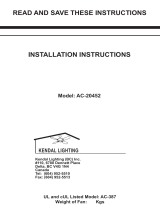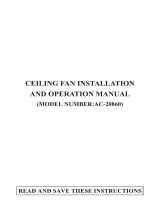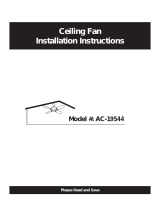Page is loading ...


1
2. PACKAGE CONTENTS
Unpack your fan and check the contents. You
should have the following items;
a. Blade set (5)
b. Hanger bracket
c. Canopy
d. Downrod
e. Coupling cover
f. Fan motor assembly
g. Set of blades bracket (5)
h. Switch housing
i. Light kit
j. Package hardware
1) Mounting hardware:
wood screws (2), screws (2), lock
washers (4), washers (2), wire nuts
(3), rubber gasket (2)
2) Blade attachment hardware:
screws (16), fiber washers (16)
3) Close-to-ceiling attachment hardware:
screws with lock washers (3)
4) Pull chain and fobs (2)
5) Balance Kit
Philips screw driver
Blade screw driver
11 mm wrench
Step ladder
Wire cutters
a
b
c
d
e
f
g
h
j
i
1. TOOLS AND MATERIALS
REQUIRED

2
3. SAFETY RULES
1. To reduce the risk of electric shock, insure
electricity has been turned off at the circuit
breaker or fuse box before beginning.
2. All wiring must be in accordance with the
National Electrical Code and local
electrical codes. Electrical installation
should be performed by a qualified
licensed electrician.
3. WARNING: To reduce the risk of shock,
this fan must be installed with an isolating
wall control/switch.
4. WARNING: To reduce the risk of personal
injury, use only the two steel screws (and
lock washers) provided with the outlet box
for mounting to the outlet box. Most outlet
boxes commonly used for the support of
lighting fixtures are not acceptable for fan
support and may need to be replaced,
consult a qualified electrician if in doubt.
5. The outlet box and support structure must
be securely mounted and capable of
reliably supporting a minimum of 50
pounds. Use only CUL Listed outlet boxes
marked "FOR FAN SUPPORT".
6. The fan must be mounted with a minimum
of 7 feet clearance from the trailing edge of
the blades to the floor.
7. Do not operate reversing switch while fan
blades are in motion. Fan must be turned
off and blades stopped before reversing
blade direction.
8. Avoid placing objects in the path of the
blades.
9. To avoid personal injury or damage to the
fan and other items, be cautious when
working around or cleaning the fan.
10. Do not use water or detergents when
cleaning the fan or fan blades. A dry dust
cloth or lightly dampened cloth will be
suitable for most cleaning.
11. After marking electrical connections,
spliced conductors should be turned
upward and pushed carefully up into
outlet box. The wires should be spread
apart with the grounded conductor and
the equipment - grounding conductor on
one side of the outlet box.
12. Electrical diagrams are reference only.
Light kit that are not packed with the fan
must be CUL Listed and marked suitable
for use with the model fan you are
installing. Switches must be CUL General
Use Switches. Refer to the Instructions
packaged with the light kits and switches
for proper assembly.
ATTENTION: Canada's Office of Energy
Efficiency requires this fan to be equipped with
a 190 watt limiting device. If lamping exceeds
190 watts, the ceiling fan's light kit will shut off
automatically.
WARNING
TO REDUCE THE RISK OF FIRE,
ELECTRIC SHOCK OR PERSONAL
INJURY, MOUNT FAN TO OUTLET BOX
MARKED "ACCEPTABLE FOR FAN
SUPPORT".
WARNING
TO REDUCE THE RISK OF PERSONAL
INJURY, DO NOT BEND THE BLADE
BRACKETS (ALSO REFERRED TO AS
FLANGES) DURING ASSEMBLY OR AFTER
INSTALLATION. DO NOT INSERT OBJECTS
IN THE PATH OF THE BLADES.

3
4. MOUNTING OPTIONS
If there isn't an existing CUL listed mounting
box, then read the following instructions.
Disconnect the power by removing fuses or
turning off circuit breakers.
Secure the outlet box directly to the building
structure. Use appropriate fasteners and
building materials. The outlet box and its
support must be able to fully support the
moving weight of the fan (at least 50 lbs). Do
not use plastic outlet boxes.
Figures 1, 2 and 3 are examples of different
ways to mount the outlet box.
Note: You may need a longer downrod to
maintain proper blade clearance when
installing on a steep, sloped ceiling. (Fig. 3)
To hang your fan where there is an existing
fixture but no ceiling joist, you may need an
installation hanger bar as shown in Figure 4.
Outlet box
Provide strong
support
Recessed
outlet box
Ceiling
mounting
plate
Outlet box
Figure 1
Figure 3
Figure 4
Outlet box
Figure 2
Angled ceiling
maximum
20 angle

Figure 7
Registration slot
4
5. HANGING THE FAN
Figure 5
Figure 6
REMEMBER to turn off the power. Follow the
steps below to hang your fan properly:
NOTE: This ceiling fan is supplied with two
types of hanging assemblies; the standard
ceiling installation using the downrod with ball
and socket mounting and the "close-
to-ceiling" installation. The "close-to-ceiling"
installation is recommended in rooms with less
than 8-feet ceilings or in areas where
additional space is desired from the floor to the
fan blades.
STANDARD CEILING INSTALLATION
Step 1. Pass the 120-volt supply wires through
the center hole in the ceiling hanger bracket as
shown in Fig. 5.
Step 2. Secure the hanger bracket to the
ceiling outlet box with the screws and washers
provided with your outlet box.
Step 3. Remove the hanger pin, lock pin and
set screws from the top of the motor assembly.
Step 4. Route wires exiting from the top of the
fan motor through the couping cover, canopy
and then through the ball/downrod. (Fig. 6)
Step 5. Align the holes at the bottom of the
downrod with the holes in the collar on top of
the motor housing. Carefully insert the hanger
pin through the holes in the collar and
downrod. Be careful not to jam the pin against
the wiring inside the downrod. Insert the
locking pin through the hole near the end of
the hanger pin until it snaps into its locked
position, as noted in the circle inset of Fig. 6.
Step 6. Tighten two set screws on top of the
fan motor firmly. (Fig. 6)
Step 7. Place the downrod ball into the hanger
bracket socket. (Fig. 7)
Downrod
Canopy
Set screws
Locking
pin
Hanger pin
Coupling cover
Hook
Mounting screws
with washers
(supplied with
electrical box)
CUL Listed
electrical box
Hanger
bracket
120V Wires

5
Figure 8
Figure 9
Figure 10
CLOSE-TO-CEILING INSTALLATION
1. Remove the decorative canopy bottom
cover from the canopy. (Fig. 8)
2. Pass the 120-volt supply wires through the
center hole in the ceiling hanger bracket as
shown in Fig. 5.
3. Secure the hanger bracket to the ceiling
outlet box with the screws and washers
provided with your outlet box.
4. Place the ceiling canopy over the collar at
the top of the motor. Align the mounting
holes with the holes in the motor and fasten
using the screws and lock washers
provided (Fig. 9).
5. Tighten the mounting screws securely. (Fig.
9)
WARNING: Failure to completely tighten the
three screws in step 5 could result in fan
loosening and possibly falling.
6. Hang the fan on the hook of the hanger
bracket. Be certain that the canopy is fully
locked into hook as shown in Fig. 10. This
will allow you to make the electrical
connections.
Canopy bottom cover
Screw and
lock washer
Canopy
Canopy
Collar
Hook

6
6. INSTALLATION OF
SAFETY SUPPORT
An additional safety support is provided to
prevent the fan from falling. Secure the safety
cable to the ceiling joist with screw and
washer, as illustrated in Figure 11.
7. MAKE THE ELECTRIC
CONNECTIONS
Remember to disconnect the power.
Follow the steps below to connect the fan to
your household wiring. Use the wire
connecting nuts supplied with your fan.
Secure the connectors with electrical tape.
Make sure there are no loose strands or
connections.
Step 1. Connect the fan supply (black) wire
and light supply (blue) wire to the black
household supply wire as shown in Figure 12.
Step 2. Connect the neutral fan (white) wire to
the white neutral household wire.
Step 3. Connect the fan ground wire (green) to
the household ground wire.
Step 4. After connecting the wires, spread
them apart so that the green and white wires
are on one side of the outlet box and the black
and the blue wires are on the other side.
Step 5. Turn the connecting nuts upward and
push the wiring into the outlet box.
Figures 13 and 14 illustrate the wiring
connections for optional wall control (The wire
color out of wall control may vary, see wall
control's installation manual for correct wire
connections.)
Hanger bracket
Safety cable
Figure 11
Figure 12
Figure 13
BLK
WIRING
BOX
GROUND TO
MOUNTING
BRACKET
OR DOWNROD
POWER LINES 120V
WH
BLUE
BLK
WH
FAN
LIGHT
BLK
BLK
WH
WH
LIGHT
SWITCH
GREEN GROUND
WH
BLUE
BLK
WH
GRN
WIRING
BOX
GROUND TO
MOUNTING
BRACKET
OR DOWNROD
BLK
BLK
WH
WH
FAN
LIGHT
POWER LINES 120V
BLK
GREEN GROUND

7
WARNING: TO REDUCE THE RISK OF
FIRE, ELECTRIC SHOCK, OR OTHER
PERSONAL INJURY. MOUNT FAN ONLY
ON AN OUTLET BOX OR SUPPORTING
SYSTEM MARKED ACCEPTABLE FOR FAN
SUPPORT.
8. FINISHING THE
INSTALLATION
STANDARD CEILING INSTALLATION
Slide canopy up to the ceiling as shown in
Figure 15. Make sure you place the wires
safely into the outlet box. Secure the canopy
to the hanger bracket with the four screws with
your fan.
CLOSE-TO-CEILING INSTALLATION
Remove the fan from the hook on the hanger
bracket. Secure the canopy to the hanger
bracket as shown in Figure 16 with four
screws included with your fan.
Figure 14
Figure 15
Figure 16
GROUND TO
MOUNTING
BRACKET
OR DOWNROD
POWER LINES 120V
GREEN
GROUND
WIRING
BOX
BLK
WH
WH
FAN
LIGHT
WH
WH
BLK
BLEU
LIGHT
FAN
Outlet box
Hanger
bracket
Canopy
Screws
Outlet box
Hanger
bracket
Canopy
Screws

8
Figure 17
Figure 18
9. ATTACHING THE FAN
BLADES
CAUTION: Remove 5 rubber packing mounts
and discard before installation.
Step 1. Attach the blade to the blade bracket
using the screws and fiber washers as shown
in Figure 17. Start screw into bracket. Repeat
for the two remaining screws.
Step 2. Tighten each screw. Make sure the
blade is straight.
Step 3. Fasten blade assembly to motor using
the screws supplied. (Fig. 17)
10. INSTALLING THE
LIGHT KIT
NOTE: Before starting installation, disconnect
the power by turning off the circuit breaker or
removing the fuse at fuse box. Turning power
off using the fan switch is not sufficient to
prevent electric shock.
Step 1. Remove the plug from the switch
housing. Attach the light kit to the switch
housing by feeding the light kit wires (black
and white) through the hole of switch housing
cover and then screw it onto the switch
housing cover by nut & lock washer. Be sure it
is tight enough to prevent light kit from
vibrating loose.
Step 2. Locate two single white and blue wires
in the switch housing labeled "FOR LIGHT".
Make the polarized plug connections:
- White to white
- Blue to black
Screws
Blade
Blades bracket
Screws with
fiber washers
Nut
Wire connectors
Washer
Plug
Light kit

9
Figure 19
Figure 20
Step 2. While holding the light kit assembly
under your fan, snap together the wire
connection plugs.
Step 3. Carefully push all wires back into the
switch housing, then install the light kit
assembly onto the mounting plate with 3
screws provided. Be sure to tighten all screws.
(Fig. 19)
Step 4. Install 3x40 Watt E12 B10.5
candelabra bulbs (not included).
Step 5. Mount the glass shade to the light
fixture by unscrewing partway the thumb
screws on the glass holder, insert the glass,
then gently tighten the thumb screws by hand
evenly to the glass. DO NOT OVER
TIGHTEN. (Fig. 20)
Step 6. Restore power and your light kit is
ready for operation.
Wire connection plugs
Screws
Bulbs
Light kit assembly
Mounting plate
Glass shade
Glass
holder
Thumb
screws

10
Figure 21
Figure 20
Figure 22
11. FAN WITHOUT LIGHT
KIT
(OPTIONAL)
Step 1. Attach the plastic plug to the switch
housing.
Step 2. Holding the switch housing under your
fan, snap together the wire connection plugs.
Step 3. Install the switch housing to the
mounting plate with screws provided. (Fig. 20)
12. OPERATING
INSTRUCTIONS
NOTE: Wait for fan to stop before changing
the setting of the slide switch.
Turn on the power and check the operation of
your fan.
1. 3-speed pull chain- it controls the fan speed
as follows: 1 pull- High, 2 pulls- Medium, 3
pulls- Low, and 4 pulls- Off.
Speed settings for warm or cool weather
depend on factors such as the room size,
ceiling height, number of fans, and so on.
2. Light pull chain it controls the light in "ON"
or "OFF".
The Reverse switch is located on the switch
housing. Slide the switch to the Left for warm
weather operation. Slide the switch to the
Right for cool weather operation.
Warm weather - (Forward) A downward air
flow creates a cooling effect as shown in
Figure 21. This allows you to set your air
conditioner on a higher setting without
affecting your comfort.
Cool weather - (Reverse) An upward airflow
moves warm air off the ceiling area as shown
in Figure 22. This allows you to set your
heating unit on a lower setting without
affecting your comfort.
Switch housing
Screws
Wire Connection
Plugs
Mounting plate

11
13. CARE OF YOUR FAN
Here are some suggestions to help you maintain your fan.
1. Because of the fan's natural movement, some connections may become loose. Check the
support connections, brackets, and blade attachments twice a year. Make sure they are
secure. (It is not necessary to remove fan from ceiling.)
2. Clean your fan periodically to help maintain its new appearance over the years. Use only a
soft brush or lint-free cloth to avoid scratching the finish. The plating is sealed with a lacquer
to minimize discoloration or tarnishing. Do not use water when cleaning. This could damage
the motor, or the wood, or possibly cause an electrical shock.
3. You can apply a light coat of furniture polish to the wood blades for additional protection and
enhanced beauty. Cover small scratches with a light application of shoe polish.
4. There is no need to oil your fan. The motor has permanently lubricated sealed ball bearings.

12
14. TROUBLESHOOTING
Problem
Fan will not start.
Fan sounds noisy.
Lights shut off and will
not come back on.
Fan wobble.
Solution
1. Check main and branch circuit fuses or breakers.
2. Check line wire connections to the fan and switch wire connections in the
switch housing.
1. Make sure all motor housing screws are snug.
2. Make sure the screws that attach the fan blade bracket to the motor hub are
tight.
3. Make sure wire nut connections are not rattling against each other or the
interior wall of the switch housing.
4. Allow a 24-hour "breaking-in" period. Most noises associated with a new fan
disappear during this time.
5. If using ceiling fan light kit, make sure the screws securing the glassware
are tight. Check that the light bulb is also secure.
6. Make sure there is a short distance from the ceiling to the canopy. It should
not touch the ceiling.
7. Make sure your ceiling box is secure and rubber isolator pads are used
between mounting bracket and outlet box.
1. This unit may be equipped with a wattage limiting device. Lamping in
excess of 190 watts will disable your ceiling fan's light kit. To reset your light
kit you must turn the power off and relamp, keeping the wattage under 190
watts. Restore power to your ceiling fan and continue normal operation.
1. Check that all blade and blade arm screws are secure.
2. Most fan wobbling problems are caused when blade levels are unequal.
Check this level by selecting a point on the ceiling above the tip of one of
the blades. Measure this distance. Rotate the fan until the next blade is
positioned for measurement. Repeat for each blade. The distance deviation
should be equal within 1/8".
3. Use the enclosed Blade Balancing Kit if the blade wobble is still noticeable.
4. If the blade wobble is still noticeable, interchanging two adjacent (side by
side) blades can redistribute the weight and possibly result in smoother
operation.
WARNING: TO REDUCE THE RISK OF PERSONAL INJURY, DO NOT
BEND THE BLADE ARM WHILE INSTALLING, BALANCING THE BLADES,
OR CLEANING THE FAN. DO NOT INSERT FOREIGN OBJECTS
BETWEEN ROTATING FAN BLADES.
/









